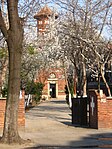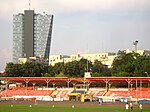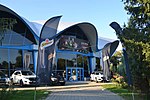Ștefan cel Mare metro station
1989 establishments in RomaniaBucharest Metro stationsEuropean rapid transit stubsRailway stations opened in 1989Romania transport stubs ... and 1 more
Romanian railway station stubs

Ștefan cel Mare is a metro station in Bucharest. Located in west-central Bucharest, it is named after Ștefan cel Mare, a medieval Moldavian prince regarded as a hero in Romania for his long resistance against the Ottoman Empire. It is located near the Dinamo Stadium. The RATB connections are 1, 5 and 46 (trams). The station was opened on 17 August 1989 as part of the extension from Gara de Nord to Dristor.
Excerpt from the Wikipedia article Ștefan cel Mare metro station (License: CC BY-SA 3.0, Authors, Images).Ștefan cel Mare metro station
Șoseaua Ștefan cel Mare, Bucharest
Geographical coordinates (GPS) Address Nearby Places Show on map
Geographical coordinates (GPS)
| Latitude | Longitude |
|---|---|
| N 44.4527 ° | E 26.10531 ° |
Address
Ștefan cel Mare
Șoseaua Ștefan cel Mare
020142 Bucharest (Sector 2)
Romania
Open on Google Maps







